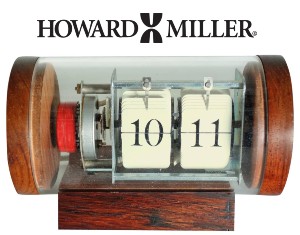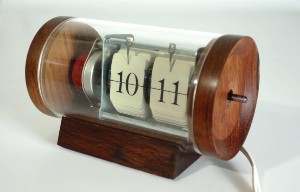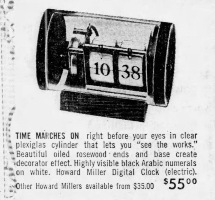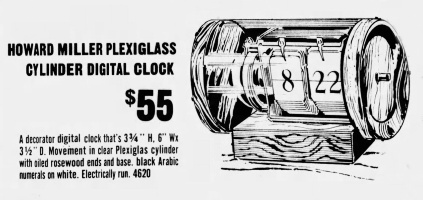 We're here to discuss a vintage flip clock that flip clock fans usually call "The Howard Miller Flip Clock." However, on online auctions you will see this clock referred to as some variation of: the Rare Vintage Arthur Umanoff George Nelson Howard Miller Flip Clock. In recent years these clocks have sold for exceedingly high prices upwards of 500 dollars and even over $1000 dollars. Why, exactly would these clocks be priced so high, when were they made? What are they made of ... "gold?, why do they have 3 men's names?, Are they really exceedingly rare and finally ... are they overpriced?
We're here to discuss a vintage flip clock that flip clock fans usually call "The Howard Miller Flip Clock." However, on online auctions you will see this clock referred to as some variation of: the Rare Vintage Arthur Umanoff George Nelson Howard Miller Flip Clock. In recent years these clocks have sold for exceedingly high prices upwards of 500 dollars and even over $1000 dollars. Why, exactly would these clocks be priced so high, when were they made? What are they made of ... "gold?, why do they have 3 men's names?, Are they really exceedingly rare and finally ... are they overpriced?
For simplicity sake, we're going to call this clock the Howard Miller Flip Clock. Period. I'll explain the other names in a minute. It's curious to note that there was another flip clock produced by Howard Miller around the same time period ... we'll discuss that one and give it a name later, I don't know. Maybe we'll call it "Fred."
Just look at it. The Howard Miller Flip Clock, if you have an interest in flip clocks, or basically, time keeping in general this clock gets your attention. It looks vintage and sort of contemporary at the same time. When I first saw it I couldn't decide if it looked like an up-cycled flip clock that you might see on Esty.com or if it was a long lost early flip clock from the 1930s.
[Note: you'll need to see the full article for details about the naming and the other Herman Miller Flip Clock.]
In the Newspapers
The Howard Miller Flip Clock first showed up in newspaper advertising right around 1969. Yes, 1969. It's vintage but not exactly an antique clock at all. Here we see the clock in this newspaper advertisement from The Philadelphia Inquirer, November 30, 1969. They're calling it the "Howard Miller Digital Clock (electric). We have a video out about when so-called digital clocks became known as flip clocks - there’s a YouTube video about that if you're interested. In this ad from the the Fort Lauderdale News, June 16, 1971 you can see they called it the "Howard Miller Plexiglass Cylinder Digital Clock." What is it with this clock and the naming confusion? In 1971 it was still priced at $55.00. Adjusted for inflation, $55.00 in 1971 is equal to about $355 in 2020. That was pricey for flip clock at that time. On the same page in this newspaper, we can see the common GE model 8114 going for a measly $9.87. So as you can see, the Howard Miller Flip Clock arrived on the scene about the time all the other makers were putting out flip clocks. The clock's run seems to have slowed or ended around 1972 since no advertisement were found after than time. As you noticed from these ads, the cylinder of the clock is not glass but Plexiglas. While PLEXIGLAS® was registered as a brand in 1933, it's use in the making of clocks did not occur significantly until the mid to late 1960s. The wood base and ends of this clock are said to oiled rosewood - not a cheap wood these days.
So why does this clock seem to be selling so high? I think that it's possible some people are mistaking the clock for an antique. It does resemble very early flip clocks, the New Haven Flip Clocks which were produced around 1937-1939.
 The Enigmatic Howard Miller Flip Clock. Also known as the George Nelson, Arthur Umanoff Howard Miller Digital Plexiglas Cylinder Digital clock, or Clock 4620 - an expensive clock in the day which has only gotten more expensive over the years. Whether the clock is worth a 1000 dollars or not is up to the buyers. It's probably not as rare as some think. Personally, I wouldn't pay a grand for it because I don't think it will hold that value. But, that's just me. As they say, "it's worth what someone would pay for it." Personally, I'd love to add this to the Flip Clock Fans collection. But for now, I'll just keep looking at it online.
The Enigmatic Howard Miller Flip Clock. Also known as the George Nelson, Arthur Umanoff Howard Miller Digital Plexiglas Cylinder Digital clock, or Clock 4620 - an expensive clock in the day which has only gotten more expensive over the years. Whether the clock is worth a 1000 dollars or not is up to the buyers. It's probably not as rare as some think. Personally, I wouldn't pay a grand for it because I don't think it will hold that value. But, that's just me. As they say, "it's worth what someone would pay for it." Personally, I'd love to add this to the Flip Clock Fans collection. But for now, I'll just keep looking at it online.










Comment